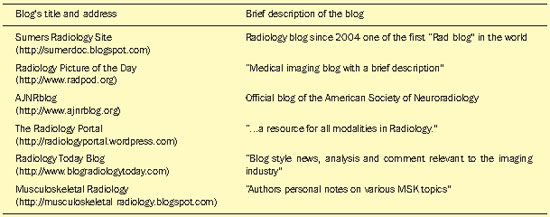Radiologia Brasileira - Publicação Científica Oficial do Colégio Brasileiro de Radiologia
AMB - Associação Médica Brasileira CNA - Comissão Nacional de Acreditação
 Vol. 44 nº 3 - May / June of 2011
Vol. 44 nº 3 - May / June of 2011
|
EDITORIAL
|
|
What is blog? How to do it? And Why? |
|
|
Autho(rs): Fabrício Guimarães Gonçalves |
|
|
Internet has definitely changed the way information is acquired and shared and altered the way people interact. It is a complex global computer network that is organized in several well-known components particularly the World Wide Web (www) and the electronic mail (E-mail). Social media (SM) networks are recently available Internet elements, which in spite of their relatively young age are currently among the most popular and visited websites internationally, particularly in Brazil.
According to a recent study performed by ComScore on the Internet audience, Brazil with around 40 million users is one the fastest growing markets and ranks 8th in the world in number of users with China on top of the list with 291.5 million. The country has the largest online population in Latin America with an average browsing time of 24.3 hours/month. Moreover the country’s online audience consumes more pages than Australia, Italy, and Taiwan combined(1). Social networking is the fastest growing segment in terms of time spent online. Facebook (http://www.facebook.com), one the most popular SM networks, has achieved the top ranking position in August 2010 in the USA, accounting for 11% of the time spent online. The website has also faced a very important growth in Brazil, in a market that has been by led by Orkut (http://www.orkut.com) for many years. In fact Orkut in Brazil has its most important market with almost 90% of its traffic. In addition, the microblog Twitter (http://www.twitter.com) in Brazil is one of its most important leader for visits/posts in Latin America(1). According to Wikipedia (http://en.wikipedia.org/wiki/Social_media) SM is “A social networking service is an online service, platform, or site that focuses on building and reflecting of social networks or social relations among people”. The free online dictionary Merriam-Webster (http://www.merriam-webster.com) defines the word blog (short term for weblog) as “A Web site that contains an online personal journal with reflections, comments, and often hyperlinks provided by the writer”. According to the blog search engine BlogPulse (http://www.blogpulse.com) there are a total of 162,785,760 identified blogs (June 6 2011). The most popular blogging sites are the WordPress (http://wordpress.org) and Blogger (http://www.blogger.com). The content of a blog is normally organized by date and categories, with the most recent post displayed first. Blogs can be hosted in two ways. The first and most common way is to remotely host on the server of the blogging network such as the two aforementioned (e.g., http://www.mypersonalblog.wordpress.com). The second is by self-hosting, which means that all the blog’s content will be published on a true domain (e.g., http://www.mypersonalblog.com). The reader may want to check for online tutorials on how to setup a blog on the following links: (http://www.siteground.com/tutorials/blog), (http://wordpress.org), (https://www.blogger.com/), and (http://www.howtomakemyblog.com/wordpress/how-to-install-wordpress-step-by-step-guide). Blogs along with other social medial have experienced a crescent interest on the medical sciences. A Manhattan Research (http://manhattanresearch.com) survey reported that 60% of US physicians are either actively using social media networks or are interested in doing so, and more than half of doctors state that they are influenced by user-generated content they consider reputable(2). A search on “blog” or “blogging”, as part of the title and abstract, in the Pubmed search engine (http://www.ncbi.nlm.nih.gov/pubmed – a service of the United States National Library of Medicine), retrieves 169 citations. A further Pubmed search on “blog” and “radiology” retrieves only three articles. A search on LILACS (http://lilacs.bvsalud.org) however, the most important and comprehensive index of scientific and technical literature of Latin America and the Caribbean, retrieves no publications. Among those three publications, the most relevant is by Sethi. The author emphasizes: “Blogging has emerged as a social phenomenon, which has impacted politics, business, and communication”. According to the author blogging software have given “geek” abilities to the layman to broadcast ideas without having specialized knowledge or programming expertise. The author uses his blog to post interesting radiology cases of his daily practice(3). Some examples of radiology blogs can be found on the table bellow. SM is continuously gaining popularity mainly because it is a relatively inexpensive and accessible vehicle to gain or deliver information as compared to more traditional media such as radio, television, print media (journal/newspaper) and films (http://en.wikipedia.org/wiki/Social_media). Among the social media elements, blogs are powerful communication tools, which will certainly become an important learning tool for the radiologist in the near future. In the view of the author adoption of radiology blogs may contribute not only to post interesting images in the Internet but also to speed up and facilitate communication between the specialists, and to serve as an additional teaching tool for the radiology resident and for the specialist in the form of continuing medical education. REFERENCES 1. Banks A. State of the Internet in Brazil. [cited 2011 Jun 6]. Available from: 2. Darves B. Social media and physicians March 2010. New England Journal of Medicine. Career Resources for Physicians. [cited 2011 Jun 6]. Available from: http://www.nejmjobs.org/career-resources/social-media-and-physicians.aspx 3. Sethi SK. Blog/web log – a new easy and interactive website building tool for a non-net savvy radiologist. J Thorac Imaging. 2007;22:115–9. MD, Fellow in Neuroradiology, McGill University Health Centre (MUHC), Montreal, Quebec, Canada. E-mail: goncalves.neuroradio@gmail.com |
|
GN1© Copyright 2024 - All rights reserved to Colégio Brasileiro de Radiologia e Diagnóstico por Imagem
Av. Paulista, 37 - 7° andar - Conj. 71 - CEP 01311-902 - São Paulo - SP - Brazil - Phone: (11) 3372-4544 - Fax: (11) 3372-4554
Av. Paulista, 37 - 7° andar - Conj. 71 - CEP 01311-902 - São Paulo - SP - Brazil - Phone: (11) 3372-4544 - Fax: (11) 3372-4554
